About two years ago I was cleaning up stuff that was leftover from my parents’ remodeling of their house. This included several sorts of things such as pretty much anything in my closet, post-college knick-knacks and some stuff from my teenage years.
This in particular was a folder that’d be the equivalent of my iPad nowadays; a bunch of writing, picture scraps and half-finished drawings.
However when going through this I found an interesting image tucked between some other paper. It was a faded color image on copier paper of an oil painting, showing a scene from the Civil War. A girl was featured on the right standing on a fence, lifting her dress to show an American flag hidden beneath.
I obviously had stuck it in there years ago, probably over a decade at least. I have no idea why it was in there, but I was guessing it was in there since about 2002-2003. Finding it in 2016, I had no idea what the painting was, who was in it or anything about the story at all.
With that burning mystery I turned to the Internet and did some research. After a bit I did find the information that I was looking for, but not much else. I had to hop several sites that just had the same information over and over again, a few rewritten with slightly different facts.
So that’s what leads me on this purpose of the article. Aside from sharing what I actually learnt along the way, I want to create a one-stop-shop of sorts that’d save you all that trouble and not throw a bunch of annoying ads or paywalls to readily get information.
This led to an actual bout of journalism which I’m proud to share, despite being terribly late on its delivery.
So we begin.
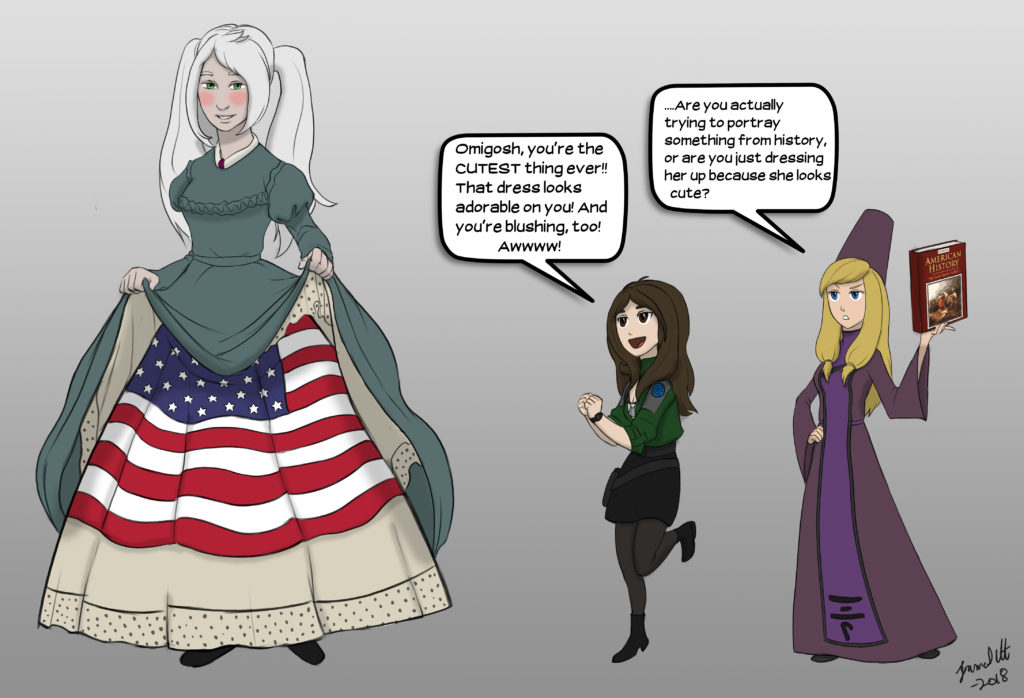
Part of Dawnstar’s crew reenacting the Petticoat Flag. Figures courtesy Christina Weinman. You can click to enlarge if text is too small to read.
Artist/Author Note: Originally because of usage rights of the image; I figured I’d play it safe and have Christina draw my own content to use. But when I actually got to talk to the actual artist behind the image, I was given permission to feature the actual painting. So yeah, that’s the explanation for my characters cosplaying as Civil War characters. Despite after the fact, it was still funny to use and we had fun taking the characters and doing this setup, so I’ll share it regardless.
–
Investigating
So when Internet searches was spinning me around in circles, I realized that maybe I could get some direct information from the actual Carthage Civil War Museum. A lot of my search results showed that it was the origin of the painting. There wasn’t an e-mail to contact anyone, but I did find a phone number to give them a ring.
I was put in touch to a woman by the name of Connie. She was very helpful and scheduled me to talk with them in greater length about Lucy’s past. This subsequent call went quite well, learning a lot of different information! While talking to her, she suggested I reach out to the actual artist of the painting Andy Thomas and some other people who might be able to help me with either photos or such. I got to briefly interview Andy on his work done on The Petticoat Flag, along with briefly talking to someone from the local Carthage newspaper.
–
History
It was the beginning years of the Civil War. The midwest was in unrest as both Confederate and Union troops marched across various places in preparation for a possible skirmish, trying to secure as much of the state as they could. The Confederate side had a lot of soldiers on their side (including the actual state guard), generally outnumbering the Union forces that had been sent to get the state in control.
With that out of the way, we turn our attention to a small town in Missouri, where our story takes place.
The Actual Event
In July 4, 1861, Union soldiers marched into Carthage. They were lead by Union Colonel Franz Siegel, passing through to catch up the state guard previously mentioned. The reports had said that they were retreating in this direction.
As they marched down the main street in the town, a young woman met the soldiers. She jumped up on a fence, displaying a Union flag hidden between her petticoats before waving it to the soldiers to see. This young woman was Lucy Hood, whose actions spawned the story of the Petticoat Flag that’s known today.
Lucy Hood
Enter our heroine Lucy Hood. About seventeen years old, she was the fifth kid of seven (later to be nine according to census records). Her father Norris C. Hood, was the county sheriff for the town. While not being born in Carthage, a good chunk of her childhood had been spent growing up there.
Before the soldiers had shown up on the July date, Lucy and a sibling had gotten together to make the Union flag that she used. This was their family’s way of showing their support for the Union. Lucy then kept the flag hidden between her skirts for safekeeping.
Hood Family History
The family was pro-Union, and was actually the only people in town aligned with that side. This fact is actually what led to the flag being hidden.
Not a whole lot of family details are known about the Hoods outside of moving around and their family tree. Per my interview sources they were a very private family, so except for their actions and later life, little or zilch is known about their actual family life.
Additional Lucy History
Lucy was born in 1844 when her family originally lived in McMinn county, Tennessee (approximately near Cleveland, northeast of Chattanooga.) They migrated west later when her family migrated to Missouri in 1852.
After the battle of Carthage, Lucy was known in the community as someone who helped develop the town. She married a man by the name of Leo Cunningham in 1867, moving into a nice log house nearby from the original Hood home (this log home is actually still standing today). She resided there for the remainder of her life, totaling to over 50 years.
Leo was responsible for at least two major developments in Carthage; he was involved in a railroad that was built into Carthage that linked to Memphis, and he and another man donated property that would be used by the town’s post office. The general attitude towards her was that she was a “true patriot”, and that she had a great interest in state and nation affairs.
Lucy divorced in 1877, but had three kids during her marriage. She passed in August 7th, 1921, at 77 years old from nephritis.
Aside from Lucy’s infamous greeting of the soldiers, she’s also noted for when she joined the family when her father had to take the Jasper county court records into safekeeping. This is another story in itself…
Hiding the Court Records
When the battle of Carthage happened, there was a large exchange of artillery fire. One side-effect of this was that the Jasper County courthouse was destroyed, burnt to the ground by fire from the bombardment.
The citizens managed to save the court records from this incident. There was a bit of a “what do we do with this” since we don’t have a courthouse, and a central operations of government ceased to exist. Initially the thought was to keep them in the bank’s safe, but the circuit county clerk went ahead to Neosho to keep them there.
Norris Hood didn’t feel that the court records would be safe there; guerrillas and bandits were quite prevalent, and the danger to the records still remained. He decided to oversee the records’ safety himself, moving them to yet another safer location.
This story gets split in two at this point, and conflicts greatly from what I dug up. But it goes as follows:
Story A: This is the version I had learned in my interview of the museum. Norris Hood went to Marshall, TX, burying the court records for safekeeping and staying there for a few years. He returned in about 1865-66, after the Civil War ended. This seems likely, especially since they were able to nail dates on his return.
Story B: This popped up while learning what I could about Lucy. Norris took some US soldiers with a wagon and his family, carrying the court records to Fort Scott in Kansas. It isn’t clear when he returned of if he stayed there.
What follows seemed extremely straightforward and reliable, also provided by my museum interview. With the war was over, Carthage and Jasper County still needed to function with its local government. But the lack of a courthouse was extremely problematic to say the least. The citizens utilized the Cave Springs schoolhouse, turning it into a center of operations for their local government. This continued for a number of years till the new Jasper County courthouse was finally constructed in the 1890s.
Lucy’s Personality
As stated above, we don’t know a whole of of what Lucy was like personality-wise. Though Connie did share one story with me:
“One day an older lady had come to visit the museum. She claimed that Myra Belle Shirley (who was an infamous outlaw by the name of Belle Starr) would often get into spats with Lucy.”
It seemed that Belle Starr was actually next door neighbors to the Carthage home, so this may have actually been true. If so, it’s actually a bit funny and gives you a bit more into her as a person.
What Actually Happened
From my conversation with Connie, there are a few different versions of the story. The most popular one is the romanticized one, which is the version that had been commissioned for their museum. This is the version that involves Lucy standing on the fence and showing it for the soldiers to see before mounting it on the courthouse flagpole.
The other version is a more factual and simpler version; Lucy simply walked to the courthouse upon the soldier’s arrival, taking the flag out from hiding and hanging it on the flagpole without incident. This is according to Lucy’s brother, a number of years later after the incident.
Yet another version more akin to the first. The claim is that the flag was actually sewn to one of her petticoats, and either Lucy simply lifted her skirts to show the flag, or removed the entire petticoat to wave to the soldiers, flag attached.
When talking to Andy, he shared a conversation he had with a descendant of a German-American soldier. This soldier in question was one of the Union soldiers that had walked into Carthage that day. When Lucy got on the fence to show the flag, the soldiers gave a “…rousing cheer. It could’ve been for the flag, or for the girl. We’ll never know.”
Both the museum and the artist agree that while it was unclear what really happened in detail, something along those lines did occur.
The Commissioning of ‘Petticoat Flag’
When the Civil War museum was opened in 1992, Andy Thomas was commissioned to depict the scene of Lucy’s ‘Petticoat Flag’. A well established artist at self-founded Maze Creek Studios, Andy also did some other pieces for the museum, including a scene depicting the battle in the town square.
Andy had done some research on Lucy’s story to prepare for this painting. Previously, he also had painted one of her descendants while they were alive. With the information he gathered, that led to the final piece below, small but well-painted oil on canvas piece at 12″ x 18″.
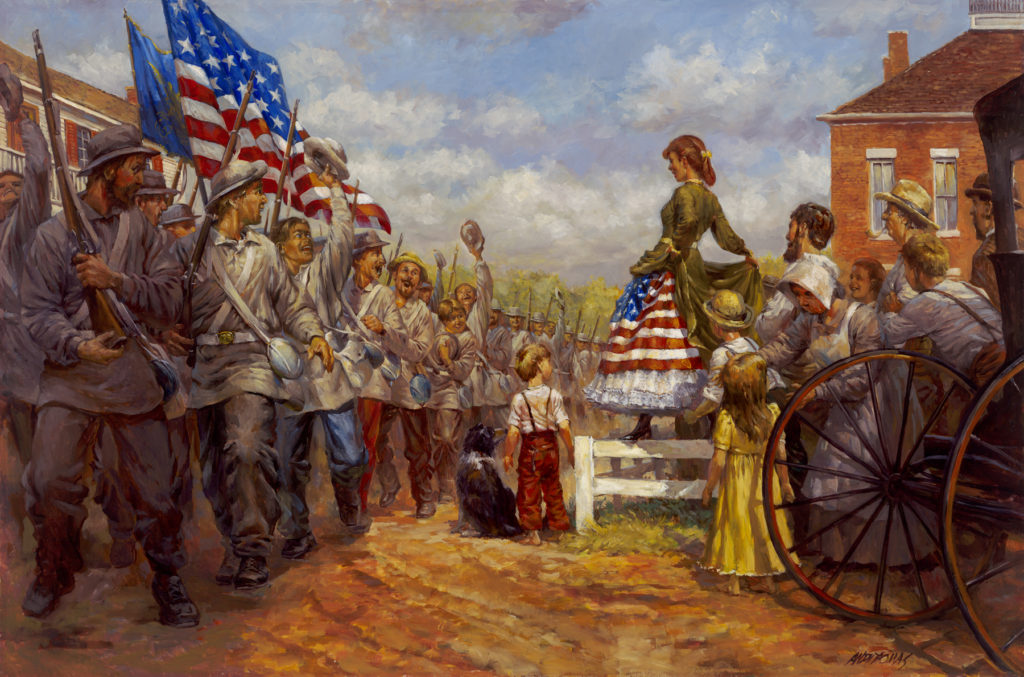
The Petticoat Flag – Courtesy of Maze Creek Studios
Clothing History 101
During our discussion, Connie was helpful in explaining Lucy’s attire. Although I had some experience with 1800’s attire for some of my writings, her insight from a historian’s perspective was worth something. I got additional help from poking around random Pinterest boards, too!
On top of all that, I know you the reader may not know what is being carried on about, so I’ve specifically typed this section up to save you Google searching. Hopefully you learn something new, too!
Per Connie’s description, Lucy’s get up consisted of a day dress with somewhat puffy sleeves, a removable collar, hoopskirt and some petticoats.
Day Dress: This is self-explanatory, a daytime working dress. Look in the gallery below for examples.
Removable collar: This seems weird to us as all of our modern clothes have their collars attached, but dresses back then had the collars separate for ease of washing. Per insight from Corture Courtesan, “dresses were often treated as a modern day suit, so the dress was only washed when needed.”
Hoopskirt: This is a ribbed skirt with multiple hoops of either whalebone or metal, strung together by some fabric strips. These varied in complexity depending on the wearer and how wealthy they were. From what I was told, Lucy’s hoopskirt would’ve been not fancy and a bit smaller than the average shape of the day.
Petticoats: Various reasons why this is worn. While most people point a “modesty” finger (which is true) there was practical purposes as well. As outlined above, most dresses weren’t tossed in the wash regularly. Petticoats helped keep sweat and such off it, those being easier to launder regularly.
Also with hoopskirt, the dress by itself often had a weird “ribbed” shape from resting directly on this. Petticoats helped to smooth this out, also giving additional weight to the upper layers to prevent it from flipping upwards.
Per Connie’s words, they didn’t dress in anything fancy, as they had a lot of kids. Fair enough, I can share that sentiment.
Gallery
What this? A gallery you say? There’s only one painting!
True! However, a few reenactors have decided to portray Lucy over the years. While a lot of these photos are lost from these events (mostly because the most notable ones took place before the advent of the digital camera), these few I did manage to find after digging around. Special thanks to the reenactors who’ve taken the time to portray Lucy and keeping history alive in this fashion.
While compiling photos and facts for this article, I also had reached out to some people in the dA art community with my project. Two dAers who did reenacting were interested, providing these photos of their own interpretations of the Petticoat Flag. Great thanks to them for their contributions!
This collection was submitted by various people in Carthage, from the local newspaper to even an author. Even the sister of of the Lucy Hood re-enactor had something to share as well! All these images appear to be from the 2011 Carthage Civil War re-enactment event.
- Alyssa Gonzales re-enacting Lucy Hood at a Carthage re-enactment. Image courtesy Lisa Livingston.
- Lucy showing her petticoat flag to greet the Union soliders. Image courtesy The Carthage Press.
- Lucy waving her petticoat flag at the Union soldiers as they march by. Image courtesy The Carthage Press.
- Candid shot of a Lucy Hood Re-enactor at the 2011 Carthage re-enactment. Image courtesy Sara Gonzales.
This set was contributed by photographer and hobby re-enactor Danielle Yrulegui, based out in California.
This contribution is from Kristen and Richard Smansky, both Civil War re-enactors from Ohio!
Lastly this popped up while searching for relevant information , and was taken by a reenactor at the Carthage 2003 event. I don’t know who she is, but the picture was taken by ChinMusic From a Greyhound.
- A photo of a Lucy Hood reenactor from 2003, Sourced from the Chin Music From a Greyhound blog.
Finally my own contribution!
First, Christina and I mashed ideas together to come up with this art; Lucy Hood in Japanese chibi style! While the coloring is digital the art style is pretty much the same doctrine (big eyes, smaller body proportions, etc)
The second is a shot from a long time friend Megan Swecker, who shows up on my Youtube channel from time to time. She provided this to me while doing something else for another project.
- Lucy Hood in Chibi style!
- A quick and candid take on Lucy Hood’s story by Megan.
In Closing
So that was an interesting journey, to say the last. It turned out hunting the origins of an old picture led me to actually do some investigative journalism, talk to some interesting folks and get to collaborate with peeps in an art community. Good day all around.
Looking back at the paper in my binder, I still can’t help but to wonder why it was still in there. Me back then was into playing Halo, watching Teen Titans and reading Star Trek novels. Why?
It took me a bit of deep thinking, but I guess I saw her as a heroine. She didn’t seem like the average woman in the romantic period movies my mom would watch on TV. At least from what I saw in the painting, Lucy seemed capable and not afraid to speak her mind. Sixteen years later, I do think she’s still a heroine of sorts. Yeah, it may seem silly that all she did was hide a flag in her skirts then show it to Union soldiers, but I kind of see more.
She gave hope to those soldiers who came, letting them know that there was at least one friendly face that supported their cause. She broke social norms, where it wasn’t really proper to go showing underskirts or jumping up on fences. Lastly, everyone in the town knew that Lucy if not her entire family supported the Union. I could only imagine the stigma if not possible danger.
So yeah, I still think that Lucy Hood with her petticoat flag is a hero.
In closing, please enjoy this little comic. Have some adventures this summer! (Click to enlarge if its too small)
Credits
Special thanks to Connie Sue and Melanie Blizzard from the Carthage Civil War Museum. Please check them out! You can visit them at 205 Grant St in Carthage, and are open from 8:30-5 Monday through Saturday, and 1-5 on Sunday.
(Yes, I give exact coordinates when handing out directions)
Megan Swecker Lamb
Sara Gonzales
Sources
–
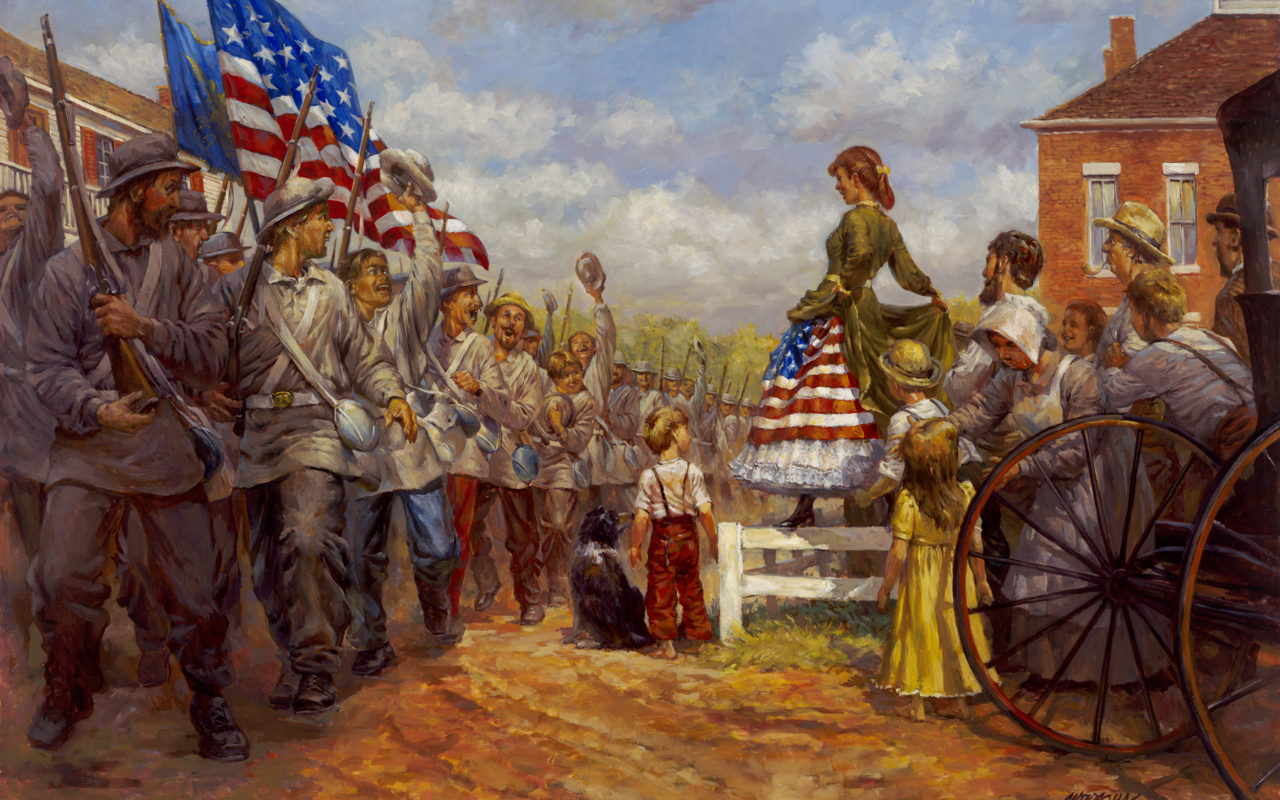
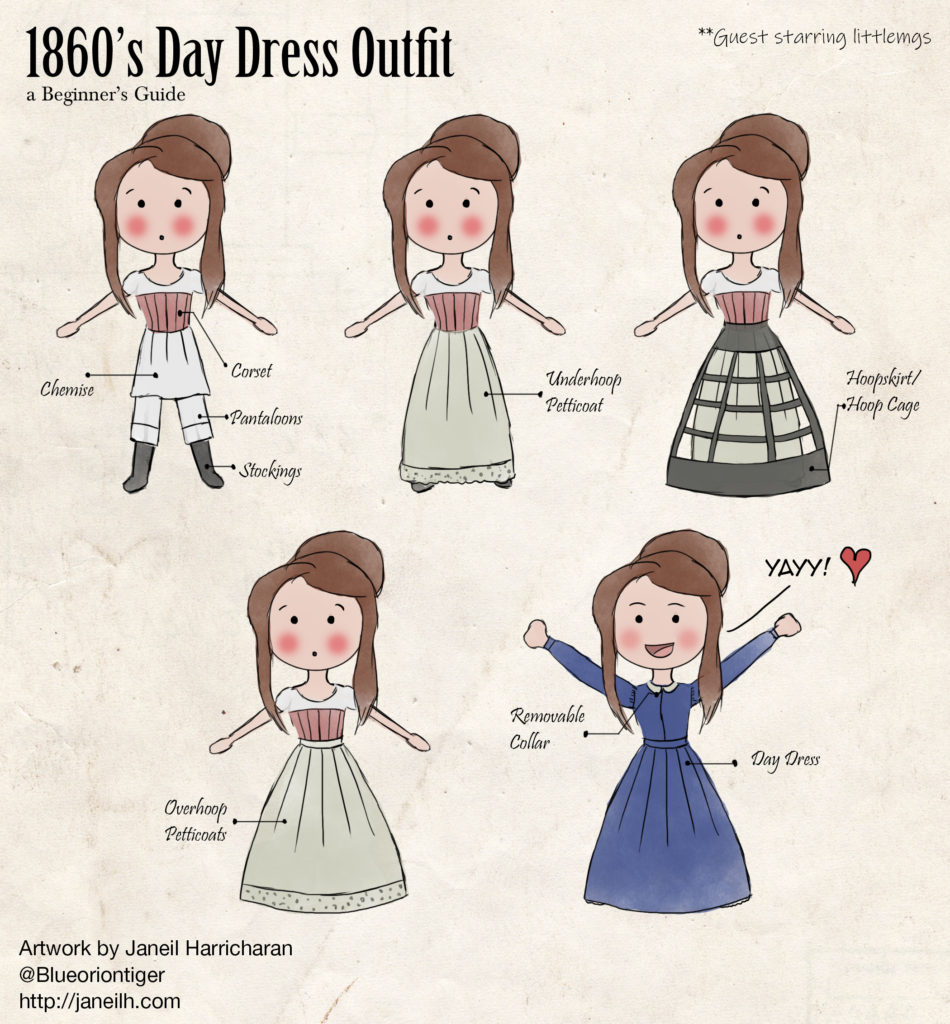
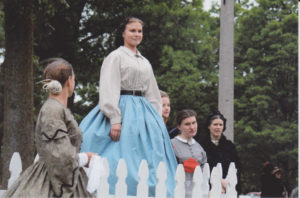
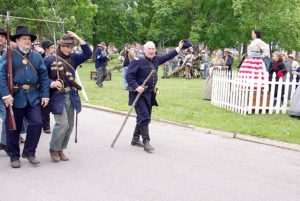
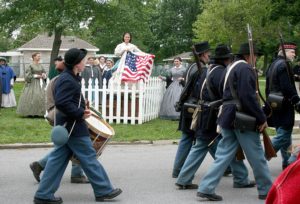
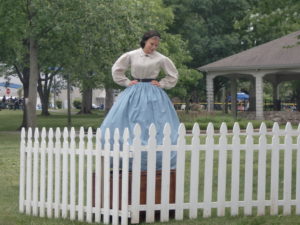
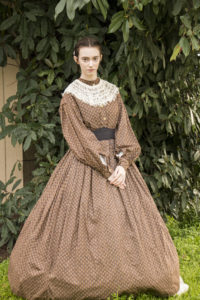
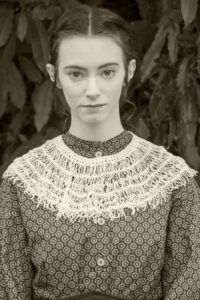
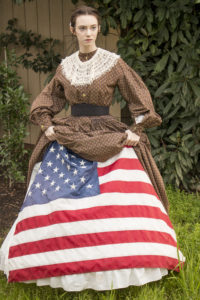
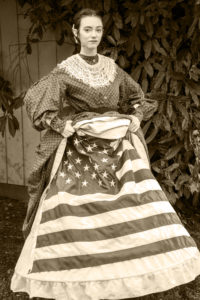

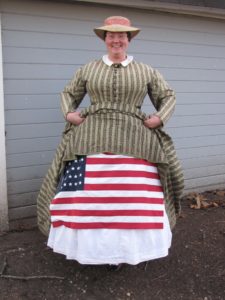
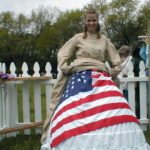


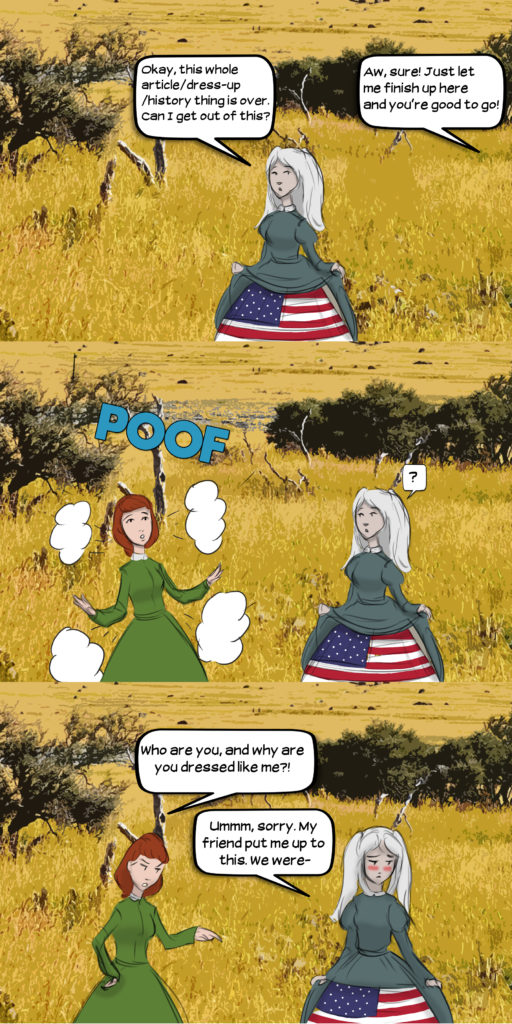
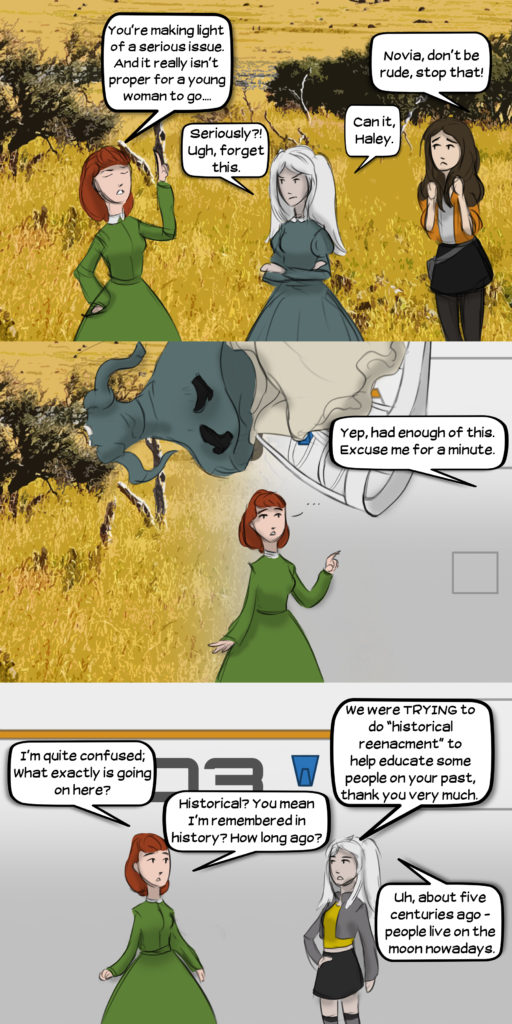
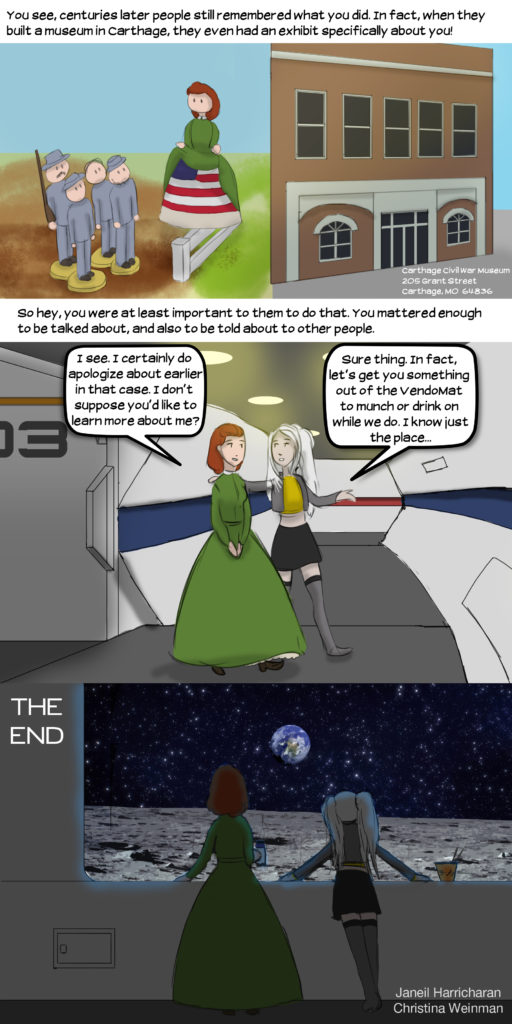
Wonderful read. You put the facts in, filled in the holes without making it fiction pretty much. It’s updated for the young modern reader, but entertaining for us old folks too. Thank you, Lavonne Budd Stockdale
Thanks, Lavonne. I wanted it to be accurate if anything, so I’m glad I accomplished that. I’m definitely glad you found it entertaining, too!